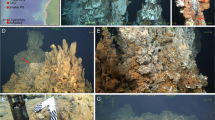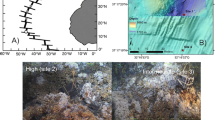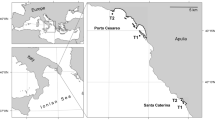Abstract
The main objective of the present study was to investigate invertebrate colonization processes at deep-sea hydrothermal vents in response to environmental factors and to the presence of complex artificial substrata (i.e., synthetic sponges). We set out a pilot experiment at 1700 m depth on the Lucky Strike vent field (Eiffel Tower, Mid-Atlantic Ridge). Synthetic sponges were deployed in 2011 at five sites along a gradient of hydrothermal activity and were recovered in 2013, and the composition of macro- and meiofauna was assessed on four of them. The influence of temperature and fluid inputs on colonizer faunal abundance and diversity was analyzed. Faunal abundance and diversity decreased with increasing distance from vent emission. The colonizers were represented by a subset of species characterizing the natural populations at the Eiffel Tower edifice. Some taxa (e.g., pycnogonids, ophiuroids, cnidarians, foraminiferans) represented new records not yet found on deployed substrata on the Eiffel Tower. Synthetic sponges harbored a high percentage (from 17.5% to 55%) of juveniles and larval stages of polychaetes, molluscs, and copepods. A mature nematode community (mainly Cephalochaetosoma and Halomonhystera) in a reproductive stage was found. Variability in faunal composition was significantly correlated with distance from fluid emission. We hypothesize that the complex structure of inorganic sponge substrata may have favored settlement of juveniles and larvae. Sponge substrata may, therefore, help sample a wider range of organisms than other substrata, and, thereby, provide a more complete picture of vent biodiversity. The results provided in this study might improve our understanding of mechanisms that govern faunal colonization processes at vents.





Similar content being viewed by others
References
Anderson MJ, Gorley RN, Clarke KR (2008) PERMANOVA+ for PRIMER: guide to software and statistical methods. PRIMER-E, Plymouth
Balazy P, Kuklinski P (2017) Arctic field experiment shows differences in epifaunal assemblages between natural and artificial substrates of different heterogeneity and origin. J Exp Mar Biol Ecol 486:178–187
Bates AE, Tunnicliffe V, Lee RW (2005) Role of thermal conditions in habitat selection by hydrothermal vent gastropods. Mar Ecol Prog Ser 305:1–15
Beaulieu SE, Baker ET, German CR, Maffei A (2013) An authoritative global database for active submarine hydrothermal vent fields. Geochem Geophys Geosys 14:4892–4905
Beaulieu SE, Baker ET, German CR (2015) Where are the undiscovered hydrothermal vents on oceanic spreading ridges? Deep Sea Res II Topical Stud Oceanogr 121:202–212
Bergquist DC, Eckner JT, Urcuyo IA, Cordes EE, Hourdez S, Macko SA, Fisher CR (2007) Using stable isotopes and quantitative community characteristics to determine a local hydrothermal vent food web. Mar Ecol Prog Ser 330:49–65
Bertness MD, Leonard GH, Levine JM, Schmidt PR, Ingraham AO (1999) Testing the relative contribution of positive and negative interactions in rocky intertidal communities. Ecology 80:2711–2726
Boeckner MJ, Sharma J, Proctor HC (2009) Revisiting the meiofauna paradox: dispersal and colonization of nematodes and other meiofaunal organisms in low- and high-energy environments. Hydrobiologia 624:91–106
Charlou JL, Donval JP, Douville E, Jean-Baptiste P, Radford-Knoery J, Fouquet Y, Dapoigny A, Stievenard M (2000) Compared geochemical signatures and the evolution of Menez Gwen (37°50′N) and Lucky Strike (37°17′N) hydrothermal fluids, south of the Azores Triple Junction on the Mid-Atlantic Ridge. Chem Geol 171:49–75
Clarke KR (1993) Non-parametric multivariate analyses of changes in community structure. Aust Ecol 18:117–143
Copley JTP, Flint HC, Ferrero TJ, Van Dover CL (2007) Diversity of meiofauna and free-living nematodes in mussel beds at hydrothermal vents on the northern and southern East Pacific Rise. J Mar Biol Assoc UK 84:1141–1152
Cuvelier D, Sarrazin J, Colaço A, Copley J, Desbruyères D, Glover AG, Tyler P, Santos R (2009) Distribution and spatial variation of hydrothermal faunal assemblages at Lucky Strike (Mid-Atlantic Ridge) revealed by high-resolution video image analysis. Deep Sea Res Part I Oceanogr Res Pap 56:2026–2040
Cuvelier D, Sarradin PM, Sarrazin J, Colaço A, Copley JT, Desbruyères D, Glover AG, Serrão Santos R, Tyler PA (2011a) Hydrothermal faunal assemblages and habitat characterisation at the Eiffel Tower edifice (Lucky Strike, Mid-Atlantic Ridge). Mar Ecol Evol Perspect 32:243–255
Cuvelier D, Sarrazin J, Colaço A, Copley JT, Glover AG, Tyler PA, Serrão Santos R, Desbruyères D (2011b) Community dynamics over 14 years at the Eiffel Tower hydrothermal edifice on the Mid-Atlantic Ridge. Limnol Oceanogr 56:1624–1640
Cuvelier D, Beesau J, Ivanenko VN, Zeppilli D, Sarradin PM, Sarrazin J (2014) First insights into macro-and meiofaunal colonisation patterns on paired wood/slate substrata at Atlantic deep-sea hydrothermal vents. Deep Sea Res I Oceanogr Res Pap 87:70–81
da Fonsêca-Genevois V, Somerfield PJ, Neves MHB, Coutinho R, Moens T (2006) Colonization and early succession on artificial hard substrata by meiofauna. Mar Biol 148:1039–1050
De Busserolles F, Sarrazin J, Gauthier O, Gélinas Y, Fabri MC, Sarradin PM, Desbruyères D (2009) Are spatial variations in the diets of hydrothermal fauna linked to local environmental conditions? Deep Sea Res II Topical Stud Oceanogr 56:1649–1664
Deprez T, Steyaert M, Vanaverbeke J, Speybroeck J, Raes M, Derycke S, De Smet G, Ingels J, Vanreusel A, Van Gaever S, Vincx M (2005) NeMys. http://www.nemys.ugent.be. Department of Marine Biology, Ghent University
Eckman JE (1987) The role of hydrodynamics in recruitment, growth, and survival of Argopecten irradians (L.) and Anomia simplex (D’orbigny) within eelgrass meadows. J Exp Mar Biol Ecol 106:165–191
Gaudron SM, Pradillon F, Pailleret M, Duperron S, Le Bris N, Gaill F (2010) Colonization of organic substrates deployed in deep-sea reducing habitats by symbiotic species and associated fauna. Mar Environ Res 70:1–12
Giere O (2009) Meiobenthology. The microscopic fauna in aquatic sediments. Springer, Berlin
Gollner S, Zekely J, Govenar B, Le Bris N, Nemeschkal HL, Fisher CR, Bright M (2007) Tubeworm-associated permanent meiobenthic communities from two chemically different hydrothermal vent sites on the East Pacific Rise. Mar Ecol Prog Ser 337:39–49
Gollner S, Miljutina M, Bright M (2013) Nematode succession at deep-sea hydrothermal vents after a recent volcanic eruption with the description of two dominant species. Org Divers Evol 13:349–371
Gollner S, Govenar B, Martinez Arbizu P, Mills S, Le Bris N, Weinbauer M, Shank TM, Bright M (2015) Differences in recovery between deep-sea hydrothermal vent and vent-proximate communities after a volcanic eruption. Deep Sea Res I Oceanogr Res Pap 106:167–182
Govenar B, Fisher CR (2007) Experimental evidence of habitat provision by aggregations of Riftia pachyptila at hydrothermal vents on the East Pacific Rise. Mar Ecol 28:3–14
Govenar B, Le Bris N, Gollner S, Glanville J, Aperghis AB, Hourdez S, Fisher CR (2005) Epifaunal community structure associated with Riftia pachyptila aggregations in chemically different hydrothermal vent habitats. Mar Ecol Prog Ser 305:67–77
Higgins RP, Thiel H (1988) Introduction to the study of meiofauna. Smithsonian Institution Press, Washington, DC, 488 pp
Hull SL (1997) Seasonal changes in diversity and abundance of ostracods on four species of intertidal algae with differing structural complexity. Mar Ecol Prog Ser 161:71–82
Humphris SE, Fornari DJ, Scheirer DS, German CR, Parson LM (2002) Geotectonic setting of hydrothermal activity on the summit of lucky strike seamount (37°17′N, Mid-Atlantic Ridge). Geochem Geophys Geosyst 3:1–25. https://doi.org/10.1029/2001GC000284
Husson B, Sarradin PM, Zeppilli D, Sarrazin J (2017) Picturing thermal niches and biomass of hydrothermal vent species. Deep Sea Res II Topical Stud Oceanogr 137:6–25
Ivanenko V, Ferrari FD, Defaye D, Sarradin PM, Sarrazin J (2011) Description, distribution and microhabitats of a new species of Tisbe (Copepoda: Harpacticoida: Tisbidae) from a deep-sea hydrothermal vent field at the Mid-Atlantic Ridge (37°N, Lucky Strike). Cah Biol Mar 52:89–106
Ivanenko VN, Corgosinho PH, Ferrari F, Sarradin PM, Sarrazin J (2012) Microhabitat distribution of Smacigastes micheli (Copepoda: Harpacticoida: Tegastidae) from deep-sea hydrothermal vents at the Mid-Atlantic Ridge, 37° N (Lucky Strike), with a morphological description of its nauplius. Mar Ecol 33:246–256
Kelly N, Metaxas A (2008) Diversity of invertebrate colonists on simple and complex substrates at hydrothermal vents on the Juan de Fuca Ridge. Aquat Biol 3:271–281
Kelly N, Metaxas A, Butterfield D (2007) Spatial and temporal patterns of colonization by deep-sea hydrothermal vent invertebrates on the Juan de Fuca Ridge, NE Pacific. Aquat Biol 1:1–16
Lutz RA, Shank TM, Luther GW III, Vetriani C, Tolstoy M, Nuzzio DB, Moore TS, Waldhauser F, Crespo-Medina M, Chatziefthimiou AD, Annis ER, Reed AJ (2008) Interrelationships between vent fluid chemistry, temperature, seismic activity, and biological community structure at a mussel-dominated, deep-sea hydrothermal vent along the East Pacific Rise. J Shellfish Res 27:177–190
Marcus J, Tunnicliffe V, Butterfield DA (2009) Post-eruption succession of macrofaunal communities at diffuse flow hydrothermal vents on Axial Volcano, Juan de Fuca Ridge, Northeast Pacific. Deep Sea Res II Topical Stud Oceanogr 56:1586–1598
Marsh AG, Mullineaux LS,Young CM, Manahan DT (2001) Larval dispersal potential of the tubeworm Riftia pachyptila at deep-sea hydrothermal vents. Nature 411(6833),77–80
McArdle BH, Anderson MJ (2001) Fitting multivariate models to community data: a comment on distance-based redundancy analysis. Ecology 82:290–297
Metaxas A, Kelly NE (2010) Do larval supply and recruitment vary among chemosynthetic environments of the deep sea? PLoS One 5(7):e11646
Mullineaux LS, Peterson CH, Micheli F, Mills SW (2003) Successional mechanism varies along a gradient in hydrothermal fluid flux at deep-sea vents. Ecol Monogr 73:523–542
Mullineaux LS, Adams DK, Mills SW, Beaulieu SE (2010) Larvae from afar colonize deep-sea hydrothermal vents after a catastrophic eruption. Proc Natl Acad Sci U S A 107:7829–7834
Ondréas H, Cannat M, Fouquet Y, Normand A, Sarradin PM, Sarrazin J (2009) Recent volcanic events and the distribution of hydrothermal venting at the Lucky Strike hydrothermal field, Mid-Atlantic Ridge. Geochem Geophys Geosyst 10(2):1–18
Palmer MA (1988) Dispersal of marine meiofauna: a review and conceptual model explaining passive transport and active emergence with implications for recruitment. Mar Ecol Prog Ser 48:81–91
Platt HM, Warwick RM (1983) Free-living marine nematodes. Part 1: British enoplids. Cambridge University Press, Cambridge
Platt HM, Warwick RM (1988) Free-living marine nematodes. Part 2: British chromadorids. Cambridge University Press, Cambridge
Plum C, Pradillon F, Fujiwara Y, Sarrazin J (2017) Copepod colonization of organic and inorganic substrata at a deep-sea hydrothermal vent site on the Mid-Atlantic Ridge. Deep Sea Res II Topical Stud Oceanogr 137:335–348. https://doi.org/10.1016/j.dsr2.2016.06.008
Romey WL, Castro KM, Dealteris JT, Bullock RC (1991) Recruitment in the deep-sea wood-boring bivalve Xylophaga atlantica Richards. Veliger 34:14–20
Sarradin PM, Waeles M, Bernagout S, Le Gall C, Sarrazin J, Riso R (2009) Speciation of dissolved copper within an active hydrothermal edifice on the Lucky Strike vent field (MAR, 37°N). Sci Total Environ 407:869–878
Sarrazin J, Cuvelier D, Peton L, Legendre P, Sarradin PM (2014) High-resolution dynamics of a deep-sea hydrothermal mussel assemblage monitored by the EMSO-Açores MoMAR observatory. Deep Sea Res I Oceanogr Res Pap 90:62–75
Sarrazin J, Legendre P, De Busserolles F, Fabri M-C, Guilini K, Ivanenko VN, Morineaux M, Vanreusel A, Sarradin P-M (2015) Biodiversity patterns, environmental drivers and indicator species on a high-temperature hydrothermal edifice, Mid-Atlantic Ridge. Deep Sea Res II Topical Stud Oceanogr 121:177–192
Schander C, Rapp HT, Kongsrud JA, Bakken T, Berge J, Cochrane S, Oug E, Byrkjedal I, Todt C, Cedhagen T, Fosshagen A, Gebruk A, Larsen K, Levin L, Obst M, Pleijel F, Stöhr S, Warén A, Mikkelsen NT, Hadler-Jacobsen S, Keuning R, Petersen KH, Thorseth IH, Peddersen RB (2010) The fauna of hydrothermal vents on the Mohn Ridge (North Atlantic). Mar Biol Res 6:155–171
Shank TM, Fornari DJ, Von Damm KL, Lilley MD, Haymon RM, Lutz RA (1998) Temporal and spatial patterns of biological community development at nascent deep-sea hydrothermal vents (9°50′N, East Pacific Rise). Deep Sea Res II Topical Stud Oceanogr 45(1–3):465–515
Sibert JR (1981) Intertidal hyperbenthic populations in the Nanaimo Estuary. Mar Biol 64:259–265
Tolstoy M, Cowen JP, Baker ET, Fornari DJ, Rubin KH, Shank TM, Waldhauser F, Bohnenstiehl DR, Forsyth DW, Holmes RC, Love B, Perfit MR, Weekly RT, Soule SA, Glazer B (2006) A sea-floor spreading event captured by seismometers. Science 314:1920–1922
Tsurumi M (2003) Diversity at hydrothermal vents. Glob Ecol Biogeogr 12:181–190
Tsurumi M, Tunnicliffe V (2001) Characteristics of a hydrothermal vent assemblage on a volcanically active segment of Juan de Fuca Ridge, northeast Pacific. Can J Fish Aquat Sci 58:530–542
Tunnicliffe V (1991) The biology of hydrothermal vents: ecology and evolution. Oceanogr Mar Biol Ann Rev 29:319–407
Tunnicliffe V, Embley RW, Holden JF, Butterfield DA, Massoth GJ, Juniper SK (1997) Biological colonization of new hydrothermal vents following an eruption on Juan de Fuca Ridge. Deep Sea Res I Oceanogr Res Pap 44:1627–1644
Van Dover CL (2002) Community structure of mussel beds at deep-sea hydrothermal vents. Mar Ecol Prog Ser 230:137–158
Van Dover CL (2003) Variation in community structure within hydrothermal vent mussel beds of the East Pacific Rise. Mar Ecol Prog Ser 253:55–66
Van Dover CL, Desbruyères D, Segonzac M, Comtet T, Saldanha L, Fiala-Medioni A, Langmuir C (1996) Biology of the Lucky Strike hydrothermal field. Deep Sea Res I Oceanogr Res Pap 43:1509–1529
Vanreusel A, Van den Bossche I, Thiermann F (1997) Free-living marine nematodes from hydrothermal sediments: similarities with communities from diverse reduced habitats. Mar Ecol Prog Ser 157:207–219
Vanreusel A, De Groote A, Gollner S, Bright M (2010) Ecology and biogeography of free-living nematodes associated with chemosynthetic environments in the deep sea: a review. PLoS One 5(8):e12449
Warwick RM, Clarke KR (1984) Species size distributions in marine benthic communities. Oecologia 61:32–41
Warwick RM, Howard HM, Somerfield PJ (1998) Free-living marine nematodes. Part 3: Monhysterids. Field Studies Council, Shrewsbury
Zekely J, Van Dover CL, Nemeschkal HL, Bright M (2006) Hydrothermal vent meiobenthos associated with mytilid mussel aggregations from the Mid-Atlantic Ridge and the East Pacific Rise. Deep Sea Res I Oceanogr Res Pap 53:1363-1378
Zeppilli D, Vanreusel A, Pradillon F, Fuchs S, Mandon P, James T, Sarrazin J (2015) Rapid colonisation by nematodes on organic and inorganic substrata deployed at the deep-sea Lucky Strike hydrothermal vent field (Mid-Atlantic Ridge). Mar Biodivers 45:489–504. https://doi.org/10.1007/s12526-015-0348-2
Acknowledgements
Special thanks go to the captains and crews of the R/V Pourquoi Pas? and the pilots of the VICTOR 6000 ROV for their great support during the MoMARSAT 2011 and BIOBAZ 2013 cruises. We are also very grateful to the LEP technical and engineering teams for their support at sea and in the laboratory. This work was supported by the “Laboratoire d’Excellence” LabexMER (ANR-10-LABX-19) and EGIDE Campus France, is co-funded by a grant from the French government under the program “Investissements d’Avenir”, and is part of the EMSO-Acores research program funded by an ANR research grant (ANR Lucky Scales ANR-14-CE02-0008-02). DZ was partially supported by the project “Prokaryote–nematode Interaction in marine extreme envirONments: a uniquE source for ExploRation of innovative biomedical applications” (PIONEER) funded by the Total Foundation and Ifremer.
Author information
Authors and Affiliations
Corresponding author
Ethics declarations
Conflict of interest
The authors declare that they have no conflict of interest.
Ethical approval
This article does not contain any studies with animals performed by any of the authors.
Field study
Permits and approval of field or observational studies have been obtained by the authors, if applicable.
Additional information
Communicated by D. Leduc
Rights and permissions
About this article
Cite this article
Baldrighi, E., Zeppilli, D., Crespin, R. et al. Colonization of synthetic sponges at the deep-sea Lucky Strike hydrothermal vent field (Mid-Atlantic Ridge): a first insight. Mar Biodiv 48, 89–103 (2018). https://doi.org/10.1007/s12526-017-0811-3
Received:
Revised:
Accepted:
Published:
Issue Date:
DOI: https://doi.org/10.1007/s12526-017-0811-3




